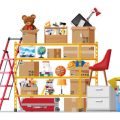Assess Your Space and Needs
Before you start shopping for home office furniture, it’s essential to understand your workspace and what you truly need. The right setup can make a big difference in how productive and comfortable you feel throughout the day. Here are some key factors to consider:
Measure Your Available Space
Start by taking accurate measurements of your home office area. Whether it’s a dedicated room or just a corner of your living space, knowing the dimensions helps you choose furniture that fits well without making the area feel cramped.
| Room Type | Suggested Furniture Size |
|---|---|
| Small Nook (under 50 sq ft) | Compact desk, wall-mounted shelves |
| Medium Room (50–100 sq ft) | Standard desk, filing cabinet, ergonomic chair |
| Large Office (over 100 sq ft) | L-shaped desk, storage units, guest seating |
Understand the Nature of Your Work
The type of work you do influences what kind of furniture youll need. For example, if youre mostly on the computer, focus on a spacious desk and an ergonomic chair. If your job involves paperwork or creative tasks like drawing or designing, you might need extra surface space or specialized workstations.
Examples Based on Job Type:
- Freelance Writer: Comfortable chair, medium-sized desk, good lighting
- Graphic Designer: Wide desk for multiple monitors or drawing tablet, storage for supplies
- Remote Customer Service Rep: Desk with cable management features, noise-canceling headset holder
List Out Your Daily Tasks
Create a list of the tasks you do every day. This helps identify features that will support those activities. For example, if youre constantly referencing documents while typing, a monitor riser with space underneath might be helpful.
Sample Daily Task Table:
| Daily Task | Recommended Furniture Feature |
|---|---|
| Email & Computer Work | Ergonomic desk and chair setup |
| Video Calls & Meetings | Desk with clean background space, adjustable lighting |
| Document Filing | File cabinet or drawer unit |
By evaluating your space, understanding your work style, and identifying daily needs, youll be better prepared to pick out furniture that not only looks good but also boosts your efficiency and comfort at home.
2. Prioritize Ergonomics and Comfort
When setting up your home workspace, one of the most important things to consider is ergonomics. Since you may be spending hours at your desk, choosing office furniture that supports good posture and minimizes physical strain is essential for your health and productivity.
Why Ergonomics Matter
Ergonomic furniture is designed to fit the human body and support natural movement. In American office settings, ergonomic standards help reduce the risk of repetitive stress injuries, back pain, and fatigue. By following these guidelines at home, you can create a more comfortable and efficient work environment.
Key Features to Look For
| Furniture | Ergonomic Features |
|---|---|
| Office Chair | – Adjustable seat height – Lumbar support – Armrests – Tilt and recline functions – Breathable material |
| Desk | – Proper height (typically 28–30 inches) – Enough legroom underneath – Option for sit-stand adjustment – Spacious surface area for equipment |
Sit-Stand Desks: A Growing Trend
Sit-stand desks are becoming increasingly popular in American home offices. They allow you to switch between sitting and standing during the day, which can improve circulation and reduce back pain. If your budget allows, this type of desk is worth considering for long-term comfort.
Tuning Your Workspace
No matter what furniture you choose, make sure everything is adjusted to fit your body properly. Your monitor should be at eye level, feet flat on the floor, and elbows at a 90-degree angle when typing. These small changes can make a big difference in how you feel throughout the day.
Selecting ergonomic furniture doesn’t just help with comfort—it boosts focus and helps you stay productive longer. So, take time to test different chairs and desks before making a purchase to ensure they meet your personal needs.

3. Consider Style and Aesthetics
When setting up your home workspace, its important to choose office furniture that not only serves a functional purpose but also matches the look and feel of your home. After all, your home office is still part of your living space. Picking pieces that blend well with your existing decor will help create a cohesive environment that’s both comfortable and motivating.
Match Your Homes Interior Design
Start by thinking about the overall style of your home. Is it modern, traditional, farmhouse, minimalist, or eclectic? Your office furniture should reflect that same aesthetic to keep the space visually consistent. For example, if you have a modern home with clean lines and neutral colors, go for sleek desks and chairs in white, black, or gray tones with metal or glass accents.
Create a Professional Yet Personal Look
Your workspace should feel professional enough to keep you focused but also personal enough to feel like your own. Consider incorporating subtle design elements that reflect your personality—like a favorite color in your chair upholstery or a desk with a finish you love. Just avoid anything too bold or distracting that might interfere with video calls or concentration.
Style Guide for Common Home Décor Themes
| Home Style | Suggested Furniture Style | Materials & Colors |
|---|---|---|
| Modern | Sleek, minimalist furniture | Glass, metal, black/white/gray tones |
| Traditional | Classic wood designs | Dark woods, warm neutrals |
| Farmhouse | Rustic and cozy pieces | Reclaimed wood, soft whites, beige |
| Minimalist | Simple and clean lines | Neutral tones, light wood, white surfaces |
| Eclectic | Mix of textures and styles | Bolder colors, vintage elements |
Add Decorative Touches Without Clutter
A few decorative items can enhance the aesthetic without overwhelming the space. Think framed artwork, stylish storage boxes, or an indoor plant. These small touches can tie the room together while making it feel more inviting.
Quick Tips:
- Stick to a color palette that complements your home.
- Avoid overly bulky or outdated furniture styles.
- Select multi-functional pieces for smaller spaces.
By taking time to consider style and aesthetics when choosing your office furniture, you’ll create a workspace that not only looks great but also inspires productivity every day.
4. Focus on Functionality and Storage
When setting up your home office, its easy to get caught up in how everything looks. But just as important—if not more—is how well your furniture works for you. Choosing pieces that offer functionality and smart storage solutions can make a huge difference in keeping your workspace tidy and productive.
Pick Furniture That Works Smarter
Look for desks, chairs, and shelves that do more than just sit there. A desk with built-in drawers or shelves can help keep your essentials within reach, while reducing desktop clutter. If space is tight, consider wall-mounted shelves or vertical storage units to make the most of your area.
Cable Management Matters
Cords from monitors, laptops, printers, and phone chargers can quickly get out of control. Choose furniture with built-in cable holes or channels to keep cords organized and out of sight. Some desks even include hidden compartments for power strips and chargers.
Think Multifunctional
Multifunctional furniture helps you save space and money. For example, a filing cabinet that doubles as a printer stand or an ottoman that opens up for storage is both practical and efficient.
Quick Comparison of Functional Features
| Furniture Piece | Key Functional Feature | Storage Option | Cable Management |
|---|---|---|---|
| L-Shaped Desk | Large workspace surface | Built-in drawers & shelves | Cable grommets included |
| Sit-Stand Desk | Adjustable height for ergonomic use | Add-on drawer units available | Cord tray underneath desk |
| Shelving Unit with Cabinet Doors | Tall vertical design saves space | Cabinets hide clutter | N/A (used for general storage) |
| Cable Organizer Tray | Keeps cords off the floor | No storage but clears space visually | Main function is cable management |
| Slim Filing Cabinet with Wheels | Easily movable under desk | Doubles as printer stand or side table | N/A (but creates more surface area) |
Your Workspace Should Work for You
The goal is to create a home office that supports your workflow, keeps distractions at bay, and helps you stay focused. By choosing furniture that combines smart design with real-world functionality, youll set yourself up for success—without compromising on style.
5. Set a Realistic Budget
Before you start shopping for your home office furniture, it’s important to determine how much you’re willing to spend. Setting a realistic budget helps you stay on track and avoid overspending. The key is to balance quality with cost—you want furniture that lasts without breaking the bank.
Know What You Need
Make a list of essential items for your workspace. This typically includes a desk, chair, storage solutions like shelves or filing cabinets, and possibly accessories like lighting or a monitor stand. Having a clear idea of what you need will help you allocate your budget wisely.
Estimate Costs
Once you’ve listed what you need, do some research to find average price ranges for each item. This gives you a ballpark figure of what your total cost might look like. Here’s an example of estimated costs for common home office furniture:
| Furniture Item | Estimated Price Range (USD) |
|---|---|
| Office Desk | $100 – $500 |
| Ergonomic Chair | $150 – $600 |
| Shelving or Storage | $50 – $300 |
| Lamp or Task Lighting | $25 – $150 |
Explore U.S.-Based Retailers and Online Platforms
The U.S. has plenty of reliable furniture retailers offering both in-store and online options. Look for stores that provide good value, durable products, and flexible return policies. Some popular places to shop include:
- IKEA USA: Affordable and modern designs with many space-saving options.
- Wayfair: Huge online selection with customer reviews and frequent sales.
- Target: Stylish and budget-friendly pieces perfect for small home offices.
- The Home Depot: Offers practical office furniture with solid build quality.
- Ashley Furniture: Known for comfortable chairs and classic desk styles.
Create a Spending Plan
If your budget is tight, consider prioritizing items by importance. For example, invest more in an ergonomic chair since youll be sitting for long hours, and spend less on decorative items at the start. You can always upgrade or add more pieces later as needed.
Savings Tip:
Look out for seasonal sales during holidays like Memorial Day, Labor Day, or Black Friday—many retailers offer deep discounts during these times.
A well-planned budget ensures youre getting the best value without sacrificing comfort or style in your home workspace.


